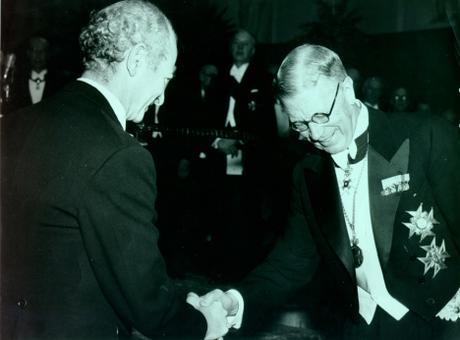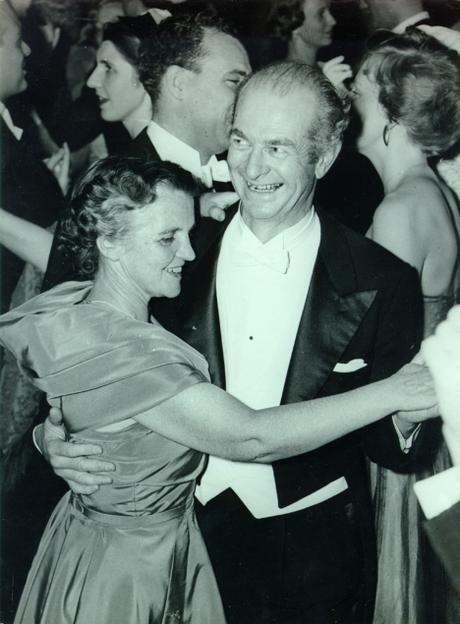
Linus Pauling shaking hands with King Gustav at the 1954 Nobel Prize Ceremony. Stockholm, Sweden. Photo Credit: Text & Bilder
[Part 5 of 6]
Today’s post focuses on those individuals who nominated Linus Pauling for the Nobel Chemistry Prize during the span of years between 1949 and his Chemistry Nobel laureate year of 1954. We also examine Pauling’s nomination for the Nobel Prize in Physiology or Medicine in 1953. The post relies on data released online by the Nobel Foundation.
Chemistry
1949:
- Jacques Hadamard: French mathematician and member of the Royal Swedish Academy of Sciences who made major contributions in number theory, complex function theory, differential geometry and partial differential equations. Having lost his two older sons in World War I and another during World War II, he became active in international peace movements.
- George Kistiakowsky: Ukrainian-American physical chemistry professor and chairholder at an invited university, Harvard. In October 1943, he was brought into the Manhattan Project as a consultant. He was soon placed in charge of X Division, which was responsible for the development of the explosive lenses necessary for an implosion-type nuclear weapon. He later served as President Dwight D. Eisenhower’s Science Advisor. He severed his connections with the government in protest against the war in Vietnam, and became active in an anti-war organization, the Council for a Livable World, becoming its chairman in 1977. At Harvard, his research interests were in thermodynamics, spectroscopy, and chemical kinetics.
- The nomination was made jointly with E.B Wilson and R.B. Woodward.
- Edgar Bright Wilson, Jr.: American chemist who received his doctorate under the Pauling’s supervision. Wilson made major contributions to the field of molecular spectroscopy and developed the theory of how rotational spectra are influenced by centrifugal distortion during rotation. He pioneered the use of group theory for the analysis and simplification of normal mode analysis, particularly for high symmetry molecules, such as benzene. Following the Second World War, Wilson conducted important work on the application of microwave spectroscopy to the determination of molecular structure.
- Robert Burns Woodward (see 1948 Zechmeister nomination in previous post)
- Charles Coryell: American chemist and co-discoverer of the element promethium. Coryell earned a Ph.D. at California Institute of Technology in 1935 as the student of Arthur A. Noyes. During the late 1930s, he engaged in research on the structure of hemoglobin in association with Linus Pauling and together they published several journal articles. When he nominated Pauling he was a chairholder at MIT, which was invited to submit nominations.
1950:
- Maurice Auméras: French chemist who, in 1950, was a chairholder at an invited university in Paris.
- Wilhelm Gerhard Burgers: Chemist who studied the structure of matter and its physical properties. He was a chairholder at an invited university in the Netherlands at Delft.
- Jean Doeuvre: French organic chemist who was a chairholder at an invited university in Lyon, France.
- Paul-Antoine Giguère: Canadian chemist and chairholder at the invited Université Laval, located in Quebec. He worked at Caltech with Pauling in the 1930s.
- Stig Claesson: Professor of chemistry at a Nordic university listed in the special regulations of 1900, the University of Uppsala, Sweden.
- Nominated with Robert Sanderson Mulliken: American physicist and chemist who was primarily responsible for the early development of molecular orbital theory, or the elaboration of the molecular orbital method of computing the structure of molecules. In 1934 he derived a new scale for measuring the electronegativity of elements. Mulliken’s scale does not entirely correlate with that developed by Linus Pauling, but is generally in close correspondence. He was a professor at the University of Chicago and received the Nobel Prize for chemistry in 1966.
1951:
- Hans Erwin Deuel: Swiss agricultural chemist at Technische Hochschule in Zurich who studied colloidal chemistry, focusing on plant gums and pectins in particular.
- Jacques Hadamard (see above)
- Bernardo Houssay: Argentine physiologist and member of the Royal Academy of Sciences who worked in the field of physiology, researching the nervous, digestive, respiratory and circulatory systems. In the 1930s, Houssay demonstrated the diabetogenic effect on anterior hypophysis extracts and the decrease in diabetes severity with anterior hypophysectomy. These discoveries stimulated the study of hormonal feedback control mechanisms which are central to multiple aspects of modern endocrinology. In 1947 he received one half of a Nobel Prize for Physiology or Medicine for his discovery of the role played by pituitary hormones in regulating the amount of glucose in animals. The other half of the prize went to Carl Ferdinand Cori and Gerty Cori, who won for their discoveries regarding the role of glucose in carbohydrate metabolism. Houssay was the first Argentine and Latin American Nobel laureate in the sciences.
- Charles P. Smyth (see 1946 nomination in previous post)
1952:
- Einar Hille: American mathematician who taught at Yale University. He was a member of both the United States National Academy of Sciences and the Swedish Royal Academy of Science.
- Arne Tiselius (see 1948 Riegel nomination in previous post)
1953:
- Edward Doisy: American biochemist and professor at St. Louis University. Doisy received the Nobel Prize in Physiology or Medicine in 1943 with Henrik Dam for their discovery of vitamin K (K from “Koagulations” which is German for “vitamin”) and its chemical structure. Doisy and Dam’s work stimulated research in endocrinology and opened up a new subfield of organic chemistry focusing on steroid compounds.
- Paul-Antoine Giguère (see above)
- Jacques Hadamard (see above)
- Felix Haurowitz: Czech-American biochemist and doctor who taught chemistry at Indiana University. He made key discoveries regarding hemoglobin and immunochemistry, including research in critical respiratory protein and spectroscopy of horse hemoglobin.
- Julian M. Sturtevant: Biochemist at Yale University and a pioneer in collecting thermodynamic and kinetic data for important biochemical reactions. He obtained a value for the enthalpy change in DNA structural transitions, which is central to the physical theories surrounding DNA structure and function. Sturtevant also developed refined calorimetric instruments that allowed for accurate heat measurements to be made of protein structural changes, which is vital to understanding protein chemistry. Using these instruments he conducted detailed studies measuring energy transfers during cellular metabolism and the mechanism of action of the various serine enzymes.
- Albert Szent-Györgyi (see 1941 nomination in previous post)
- Reine Leimu: A chemist based in Turku, Finland.
- Karl Freudenberg: German chemist who did early seminal work on the absolute configurations of carbohydrates, terpenes, and steroids, and on the structure of cellulose and other polysaccharides. He also researched the nature, structure, and biosynthesis of lignin. The Research Institute for the Chemistry of Wood and Polysaccharides was developed at the University of Heidelberg for him.

Ava Helen and Linus Pauling dancing at the 1954 Nobel Ball. Photo Credit: Pressens Bild, Stockholm.
1954:
- Edward Doisy (see above)
- Jacques Hadamard (see above)
- Albert Szent-Györgyi (see above)
- Irène Joliot-Curie: Working in Paris either alone or in collaboration with her husband, Frédéric Joliot-Curie, at the Institut du Radium, Joliot-Curie conducted important work on natural and artificial radioactivity, transmutation of elements, and nuclear physics. She shared the 1935 Nobel Prize in Chemistry with her husband, a recognition of their work synthesizing new radioactive elements. She was also Commissioner for Atomic Energy in France and oversaw construction of first French cyclotron. Throughout her career she took an interest in the social and intellectual advancement of women.
- Frédéric Joliot-Curie: Physicist working at the Institut du Radium in Paris. Collaborating with his wife, Irène, Joliot-Curie discovered that radioactive elements decompose spontaneously, usually with a long period, by emitting positive or negative particles.
- Rolf Helmer Roschier: Finnish chemist and professor of wood chemistry at the Helsinki University of Technology. He studied terpenes, the manufacturing of wood pulp, and paper and wood saccharification.
- Terje Enkvist: Finnish chemist at the University of Helsinki. He worked in the field of wood chemistry.
- Niilo Johannes Toivonen: Finnish chemist and professor at the University of Helsinki. He also worked with pharmaceutical companies and on the editorial board for a Finnish encyclopedia.
- Jean-Francois Wyart: Based in Paris when he nominated Pauling for the Nobel Prize, he worked in crystal structures and spectrochemistry.
- Arne Tiselius (see 1948 Riegel nomination in previous post)
- Theodor Svedberg: A Swedish chemist at Uppsala University, he won the Nobel Prize in Chemistry in 1926 “for his work on disperse systems.” Svedberg’s research focused primarily on colloids and macromolecular compounds. His work with colloids supported the theories of Brownian motion put forward by Albert Einstein and the Polish geophysicist Marian Smoluchowski, and therein contributed additional proof to the existence of molecules. To support his experimentation, Svedberg developed the technique of analytical ultracentrifugation, and demonstrated its utility in distinguishing pure proteins from one another. Svedberg also studied the physical properties of colloids, such as their diffusion, light absorption, and sedimentation, from which it could be concluded that the gas laws could be applied to disperse systems.
- Freudenberg (see above)
- Nominated with Hans Lebrecht Meerwein: German organic chemist who discovered cationic rearrangement reactions, carbenes, and an important alkylating reagent. He is known primarily for his work on the reduction of aldehydes and ketones with aluminum alcoholates. Through his research he clarified the mechanism of many organic reactions.
- Harlow Shapley: American astronomer and professor at Harvard. He used RR Lyrae stars to correctly estimate the size of the Milky Way Galaxy and the sun’s position within it, and found that galaxies tend to occur in clusters, which he called metagalaxies. In 1953 he proposed his “liquid water belt” theory, now known as the concept of a habitable zone. He believed that national or international affairs should be given higher priority than research and writing.
- Nominated with Robert Burns Woodward (see 1948 Zechmeister nomination in previous post)
- Shapley’s first choice was Pauling and his second choice was Woodward.
Physiology or Medicine
1953:
- John Tileston Edsall: Early protein scientist and professor of biochemistry at Harvard who contributed significantly to the understanding of the hydrophobic interaction. He was active in preserving the history of protein science, and devoted to the study of proteins and their constituent amino acids. His early work contributed to establishing proteins as unique, large structured molecules that deserved the same intense study as had become commonplace for the chemistry of small molecules.
- Nominated with Frederick Sanger: British biochemist who won the Nobel Prize in Chemistry in 1958 “for his work on the structure of proteins, especially that of insulin.” He also received one quarter of a Nobel Prize in Chemistry in 1980, split with Paul Berg – who received one half of the Prize “for his fundamental studies of the biochemistry of nucleic acids, with particular regard to recombinant-DNA” – and with Walter Gilbert who received one quarter of the Prize with Sanger “for their contributions concerning the determination of base sequences in nucleic acids.”
- Nominated with Robert Brainard Corey: American biochemist, mostly known for his role in the discovery of the α-helix and the β-sheet with Linus Pauling. Their discoveries were remarkably correct, and their bond lengths remained the most accurate for the next forty years. The α-helix and β-sheet are two structures that are now known to form the backbones of many proteins. While it was Pauling who had the intuition and imagination that produced these concepts, it was Corey who was primarily responsible for proving them correct by carrying out the necessary diffraction experiments. Together, Pauling and Corey authored more than 30 papers.
